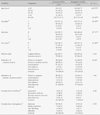Abstract
Purpose
The purpose of this study was to compare birth outcomes between Korean women and immigrant women.
Methods
Medical records were reviewed retrospectively from 201 immigrant women and 201 Korean women who delivered babies at K women's hospital in U city from January 2006 to December 2009. Maternal outcomes related factors included nationality, age, obstetric history, delivery type, indications of cesarean section, and complications of pregnancy and delivery. Principal neonatal outcomes were birth weight, Apgar scores, and complications of newborns.
Results
Immigrant women were younger and had fewer pregnancies, abortions, and surviving children than Korean women. The rate of primary cesarean section and its indication in immigrant women were not significantly different from Korean women. However, immigrant women's newborn were more likely to have low birth weight and meconium staining.
Conclusion
The results of this study indicate less equity of immigrant women in women's health care, although immigrant women's babies had lower Apgar score and more meconium staining. Nurses should help immigrant women cope with labor process effectively to prevent adverse health outcomes for their newborns.
Figures and Tables
References
1. Agudelo-Suárez A.A., Ronda-Pérez E., Gil-González D., González-Zapata L.I., Regidor E. Relationship in Spain of the length of gestation and the birth weight with mother's nationality during the period 2001-2005. Revista Española de Salud Pública. 2009. 83(2):331–337.
2. Bollini P., Pampallona S., Wanner P., Kupelnick B. Pregnancy outcome of migrant women and integration policy: a systematic review of the international literature. Social Science & Medicine. 2009. 68(3):452–461.
3. Cho S.Y., Kyo H.J. A comparative study of primiparas' perception of delivery experience and identity as the mother according to delivery methods. Korean Journal of Women Health Nursing. 1999. 5(1):5–17.
4. Essén B., Bödkerb B., Sjöberga N., Langhoff-Roosb J., Greisenc G., Gudmundssona S., et al. Are some perinatal deaths in immigrant groups linked to suboptimal perinatal care services? BJOG: An International Journal of Obstetrics and Gynaecology. 2002. 109(6):677–682.
5. Gagnon A.J., Carnevale F.A., Saucier J.F., Clausen C., Jeannotte J., Oxman-Martinez J. Do referrals work? Responses of childbearing newcomers to referrals for care. Journal of Immigrant and Minority Health. 2010. 12(4):559–568.
6. Gispert Magarolas R., Clot-Razquin G., Torné M.M., Bosser-Giralt R., Freitas-Ramírez A. Differences in reproductive patterns between autochthonous and immigrant women living in Catalonia. Gaceta sanitaria/S.E.S.P.A.S. 2008. 22(6):574–577.
7. Gissler M., Alexander S., MacFarlane A., Small R., Stray-Pedersen B., Zeitlin J., et al. Stillbirths and infant deaths among migrants in industrialized contries. Acta obstetricia et gynecologica Scandinavica. 2009. 88(2):134–148.
8. Harley K., Eskenazi B. Time in the United States, social support and health behaviors during pregnancy among women of Mexican descent. Social Science Medicine. 2006. 62(12):3048–3061.
9. Henderson E., Love E.J. Incidence of hospital-acquired infections associated with cesarean section. The Journal of Hospital Infection. 1995. 29(4):245–255.
10. Henderson J., McCandlish R., Kumiega L., Petrou S. Systematic review of economic aspects of alternative modes of delivery. BJOG: An International Journal of Obstetrics and Gynaecology. 2001. 108(2):149–157.
11. Jazayeri A., Jazayeri M.K., Sahinler M., Sincich T. Is meconium passage a risk factor for maternal infection in term pregnancies? Obstetrics and Gynecology. 2002. 99(4):548–552.
12. Jeong G.H., Koh H.J., Kim K.S., Kim S.H., Kim J.H., Park H.S., et al. A survey on health management of during pregnancy, childbirth, and the postpartum of immigrant women in a multi-cultural family. Korean Journal of Women Health Nursing. 2009. 15(4):261–269.
13. Kim H.S., Choi Y.S., Jang S.B., Jeon E.M., Jung J.W. A study on needs of women in labor to have family participation during the labor process. Korean Journal of Maternal Child Health Nursing. 1993. 3(1):38–48.
14. Kim S.K. Multicultural families in Korea: Their socioeconomic characteristics in a policy perspective. Health and Welfare Policy Forum. 2010. 165:5–18.
15. Kim Y.L. Women-immigrants' lives and their social-cultural accommodation-related policy for the multi-cultural society. Journal of Asian Women. 2006. 45(1):143–189.
16. Marriage rate for Korean men and foreign women: Population movement study. Korea National Statistical Office. 2008. Retrieved November 28, 2008. from http://Kosis.nso.go.kr.
17. Lilford R.J., Groot H.A., Moore P.J., Bingham P. The relative risks of Cesarean section (intrapartum and elective) and vaginal delivery: A detailed analysis to exclude the effects of medical disorders and other acute pre-existing physiological disturbances. British Journal of Obstetrics and Gynaecology. 1990. 97(10):883–892.
18. Ludwig D.S., Currie J. The association between pregnancy weight gain and birth weight: A within-family comparison. Lancet. 2010. 376(9745):984–990.
19. Malin M., Gissler M. Maternal care and birth outcomes among ethnic minority women in Finland. BMC Public Health. 2009. 9:84–97.
20. Park H.S., Bae K.E., Kim D.H., Yoon A.R. Health Status of Married Immigrant Women in Busan. Journal of Korean Academy of Fundamentals of Nursing. 2008. 15(1):80–88.
21. Rao A.K., Daniels K., El-Sayed Y.Y., Moshesh M.K., Caughey A.B. Perinatal outcomes among Asian American and Pacific Islander women. American Journal of Obstetrics and Gynecology. 2006. 195(3):834–838.
22. Ryoo K., Piao Y. The change in the fertility rates and the determinants of birth interval of Korean women. Korea Journal of Population Studies. 2009. 32(1):1–23.
23. Urquia M.L., Glazier R.H., Blondel B., Zeitlin J., Gissler M., Macfarlane A., et al. International migration and adverse birth outcomes: role of ethnicity, region of origin and destination. Journal of Epidemiology and Community Health. 2009. 64(3):243–251.




 PDF
PDF ePub
ePub Citation
Citation Print
Print






 XML Download
XML Download